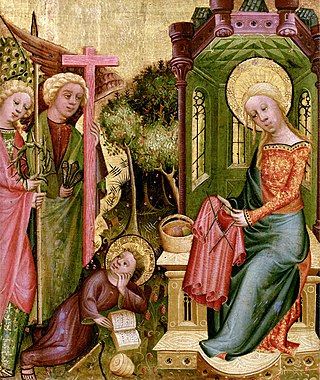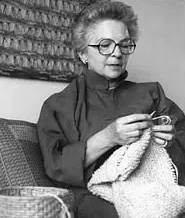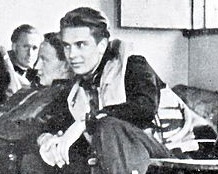
Knitting is a method for production of textile fabrics by interlacing yarn loops with loops of the same or other yarns. It is used to create many types of garments. Knitting may be done by hand or by machine.

In Norwegian knitting, a selburose is a knitted rose pattern in the shape of a regular octagram. It is traditionally used for winter clothing such as the Selbu mitten (selbuvott) and sweaters. Of ancient origin, the pattern is associated with the town of Selbu in Norway, and has become an international symbol of Norway, Christmas and winter.

The Aran jumper, also called a fisherman's jumper or a gansey, is a style of jumper that takes its name from the Aran Islands off the west coast of Ireland. A traditional Aran Jumper usually is off-white in colour, with cable patterns on the body and sleeves. Originally the jumpers were knitted using unscoured wool that retained its natural oils (lanolin) which made the garments water-resistant and meant they remained wearable even when wet.

Knitting is the process of using two or more needles to pull and loop yarn into a series of interconnected loops in order to create a finished garment or some other type of fabric. The word is derived from knot, thought to originate from the Dutch verb knutten, which is similar to the Old English cnyttan, "to knot". Its origins lie in the basic human need for clothing for protection against the elements. More recently, hand knitting has become less a necessary skill and more of a hobby.

A guernsey, or gansey, is a seaman's knitted woollen sweater, similar to a jersey, which originated in the Channel Island of the same name, sometimes known as a knit-frock in Cornwall, especially Polperro.

Elizabeth Zimmermann was a British-born hand knitting teacher and designer. She revolutionized the modern practice of knitting through her books and instructional series on American public television.
Alice Starmore is a professional needleworker, knitting designer, photographer and writer, born in Stornoway, Western Isles, Scotland. As an author she is best known for her widely-read Alice Starmore's Book of Fair Isle Knitting, a guide to the complex technique of knitting pullovers and other items using a palette of five colours, on which she is an expert. Her photographic work is devoted to the natural world, especially birds and insects.
Sweater design is a specialization of fashion design in which knitted sweaters are designed to fulfill certain aesthetic, functional and commercial criteria. The designer typically considers factors such as the insulating power of the sweater ; the fashion of its colors, patterns, silhouette and style lines, particularly the neckline and waistline; the convenience and practicality of its cut; and in commercial design, the cost of its production and the profitability of its price point. Sweater designs are often published in books and knitting magazines. Sweater design is an old art, but continues to attract new designers such as Nicky Epstein and Meg Swansen.

Knitted fabric is a textile that results from knitting, the process of inter-looping of yarns or inter-meshing of loops. Its properties are distinct from woven fabric in that it is more flexible and can be more readily constructed into smaller pieces, making it ideal for socks and hats.

Mary Walker Phillips, was an American textile artist, author and educator. She revolutionized the craft of hand knitting by exploring knitting as an independent art form. Her hand-knit tapestries and other creative pieces are exhibited in museums in the U.S. and Europe. She was honored as a fellow by the American Craft Council (ACC) in 1978.

A lopapeysa or Icelandic sweater is an Icelandic style of sweater originating in early or mid-20th century, at a time when imports had displaced older and more traditional Icelandic clothing and people began to search for new ways to utilize the plentiful native wool. The design has since become a national icon for Icelandic cultural identity.
Nicky Epstein is a knitting designer and author of books on knitting. She is known for her creative combinations of knitting stitches, and for the colorful patterns often found in her sweaters, especially involving applique of separately knitted motifs. In 2005, she was given an award by the National NeedleArts Association. In 2006, her work was included in a retrospective fashion show at the Museum of Arts and Design in New York City. Since the (winter) Holiday 2005 issue, Epstein has written a regular column in Vogue Knitting called "Nicky Epstein".
Beate Marie Eriksen is a Norwegian actress and director. Eriksen has acted at several Norwegian theatres and is known for her role in the soap opera Hotel Cæsar.

Marius Eriksen was a Norwegian skier, fighter pilot, model and actor.

Cowichan knitting is a form of knitting characteristic of the Cowichan people of southeastern Vancouver Island, British Columbia. The distinctively patterned, heavy-knit Cowichan sweaters, popular among British Columbians and tourists, are produced using this method. Cowichan knitting is an acculturated art form, a combination of European textile techniques and Salish spinning and weaving methods. From this union, new tools, techniques and designs developed over the years.

Oleana is a textile manufacturing company located in Arna, Norway, a borough of Bergen. It is known for its manufacture of knitted clothing and blankets designed by Solveig Hisdal.
Women's Home Industries was a company founded in 1947 in London to earn export revenue for the UK in the post-war period by harnessing women's craft skills, such as knitting and needlework.

Norwegian knitting (strikking) has a history dating from the 16th century.

Bohus Stickning was a Swedish knitting cooperative that was active between 1939 and 1969. It was established as a cottage industry to provide income for poor families in Bohuslän (Sweden) during the Great Depression. Knitwear designed by the founder Emma Jacobsson and other designers was handknit by women in Bohuslän Province and sold to department stores, boutiques and fashion houses both in Sweden and internationally.

Selbuvott is a knitted woolen mitten, based on a pattern from Selbu in Norway. Like all mittens, the purpose of selbuvott is to keep hands warm during winter, with one large space for fingers and a separate smaller section for the thumb. The pattern is a Selburose, which is a traditional rose from the Selbu area, shaped like an octagram. Marit Guldsetbrua Emstad first knitted the pattern into a pair of mittens in 1857, and sold it through Husfliden in Trondheim in 1897. Selbuvott is possibly the most-worn knitted pattern in Norway.















